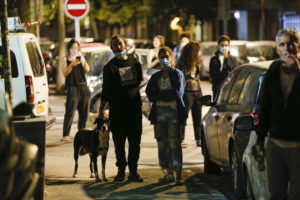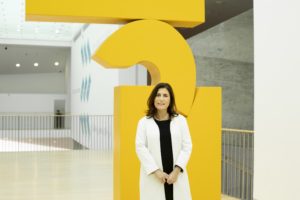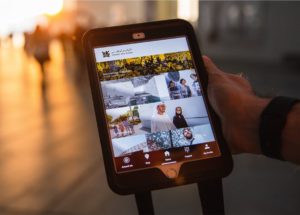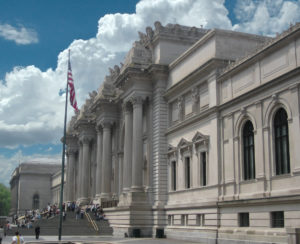With doors shut, cultural institutions take art to the streets – and online – ahead of International Museum Day
Though their doors may be closed, museums are welcoming visitors via their home-computer screens with a medley of virtual programs intended to make art feel a little more accessible during lockdowns.
The cultural sector was in fact among the first to be severely affected by the coronavirus outbreak. Most museums around the world remain shuttered even as some countries move toward easing lockdowns.
On International Museum Day, held annually on May 18, thousands of institutions traditionally offer the public a rich array of free programming to entertain and educate people, both young and old. But this year’s celebration, taking place under the cloud of a pandemic, promises to be quite different.
From collections and tours to films and lectures, museums have quickly embraced digital technologies in order to stay relevant as they grapple with social distancing regulations.
So what can they do when physical visits are no longer permitted?
“We decided that if people can’t come to the museum, then the museum will come to the people,” Tania Coen-Uzzielli, director of the Tel Aviv Museum of Art, told The Media Line.
The museum is bringing art to the streets by projecting video works from its collection directly onto buildings in the bustling coastal city. (Some are viewable on Facebook Live.) Since late April, it has screened the works of local Israeli artists like Ben Hagari, Gilad Ratman and Hila Lulu, to name but a few.
“We’ve invited people to [see] art from their balconies,” Coen-Uzzielli said. “We coordinated this event with the police, the Ministry of Health and everyone [else] in order to avoid any kind of crowding.”

People watch as the Tel Aviv Museum of Art projects some of its works on the city’s buildings. (Guy Yechiely)
Meanwhile, the Tel Aviv museum’s long-awaited exhibition of renowned sculptor Jeff Koons remains viewable online, along with several other shows that have also gone virtual. Koons was slated to attend the opening of his first solo Israeli show back in March but cancelled the visit due to the new travel restrictions implemented as a result of the coronavirus.
“Most museums are currently working via their websites, Facebook and Instagram, giving all kinds of virtual lectures and visits,” Coen-Uzzielli explained. “Together with this, museums have long been tied to a physical, rather than a virtual, experience…. When you are standing in front of [a piece of] artwork, it’s a different experience.”
In addition to its online offerings and video projections, the museum has also invited leading Israeli photographers like Vardi Kahana to document its empty indoor and outdoor spaces in a bid to support the local artistic community, which is suffering from the economic fallout.
“The artworks are wrapped up and protected. There are no people around. The cafes and restaurants are closed,” Coen-Uzzielli said of the documentary project. “When the museum’s everyday activities are not taking place as normal, everything feels and looks changed. It’s as if ghosts were wandering its halls.”
The museum director hopes the facility will reopen to some extent in the coming weeks, regulations permitting, because at the moment, it is taking a hit financially.

Tania Coen-Uzzielli, director of the Tel Aviv Museum of Art. (Roni Cnaani)
Last week, the government announced that museums and other cultural centers could reopen as early as May 17 if reports of new cases of coronavirus in the country remain stable. However, the number of people who would be allowed to enter at any given time would be limited.
Other museums in Israel are similarly turning to online activities as they weather the pandemic.
The Israel Museum in Jerusalem is offering a range of online activities for digital visitors. Self-guided tours, children’s activities and lectures are all available on its website.
“The [museum] should be commended for nimbly launching digital initiatives, such as the mini-website, curator-led tours, and specific activities for children, post-closure and during these challenging times,” a spokesperson told The Media Line, declining to offer information about a potential reopening date.
Other museums in the region and around the world appear to be taking a cautious approach toward reopening as well.
“As of right now, we still do not have a date [on] which we know when the museum will be back and open,” a spokesperson for the Louvre Abu Dhabi, one of the Middle East’s premier cultural institutions, told The Media Line in an email. “Our main concern is the safety and health of our clients and staff, which is why the museum is fully closed until further notice.”
The Louvre Abu Dhabi has launched a 360-degree virtual tour of its latest international exhibition, “Furusiyya: The Art of Chivalry between East and West.” As part of the exhibition, which explores knightly culture throughout history, it is offering a downloadable audio tour, a children’s booklet and an e-book of the, all available online free of charge.

The Louvre Abu Dhabi’s mobile application, showcasing its ‘Art from Home’ program. (Department of Culture and Tourism, Abu Dhabi)
The spokesperson added that the museum had joined a government-led initiative called CulturAll, which will see many of Abu Dhabi’s cultural landmarks go virtual.
Museums outside the Middle East are also reeling from the economic fallout of the pandemic.
The Metropolitan Museum of Art in New York City, the fourth most-visited museum in the world, was set to celebrate its 150th birthday last month. Instead, it announced it would be laying off 80 employees and slashing executive salaries as it expects to lose $150 million over the next fiscal year.
“As we bear witness to these unprecedented challenges, we should take a moment to reflect on historical events for perspective,” a statement from the museum’s president, Daniel H. Weiss, and director, Max Hollein, said. “This, of course, is what museums do best; they enable us to interpret our past so that we can try to make sense of the present. It has been heartening to see how The Met and other museums around the world have been working remotely to support communities and further outreach while our physical buildings remain closed.”

A view of the entrance to New York City’s Metropolitan Museum of Art. (Wikimedia Commons/Arad)
While the Met had initially planned to reopen in July, a spokesperson confirmed to The Media Line that it will be holding off even longer as New York continues to suffer from the largest number of confirmed cases of coronavirus – and the highest death toll – in the United States.
Nevertheless, in order to allow audiences to enjoy some of its cultural offerings, it has launched the #MetAnywhere program, which features a selection of online content and social media programs. Among these are 360-degree views of iconic museum spaces, behind-the-scenes videos and virtual exhibits.

A 360-degree view of one of the iconic halls inside the Met. (Metropolitan Museum of Art)
The Met is also hosting a number of virtual events on an almost daily basis, including live performances, art-making programs and conversations with curators and museum educators.
On the other side of the country, museums also quickly altered their programming.
Days after California’s stay-at-home orders went into effect, the Los Angeles County Museum of Art (LACMA) created a showcase of free digital media, including short films, exhibition walkthroughs and documentaries.
Every Monday, it shares a selection of artworks and activities for all to see, such as educational videos for adults and children and hands-on activities for people in English and Spanish. The museum has billed the initiative “LACMA @ Home.”
“The museum doesn’t currently have projections or street displays [although the] outdoor sculptures Levitated Mass by Michael Heizer and Urban Light by Chris Burden remain open, in addition to Miss Forest, by Yoshitomo Nara…,” a spokesperson for LACMA explained to The Media Line. “We are actively reviewing the possibility of extending exhibitions that are affected by the museum’s temporary closure.”